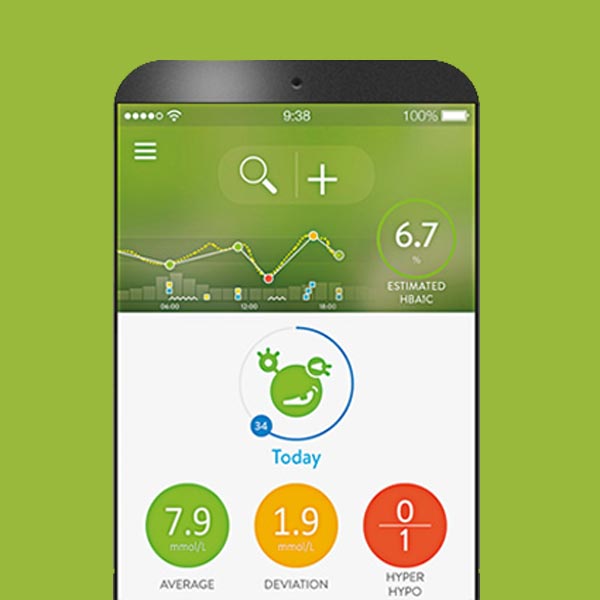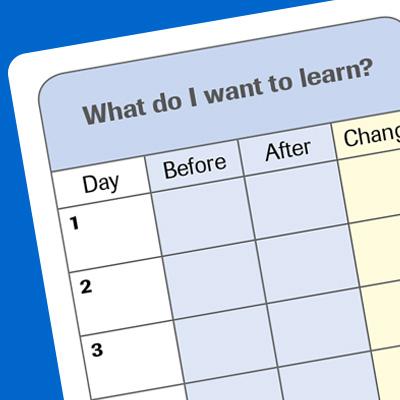Accu-Chek 360° View tool
Using a structured way of checking blood glucose, such as the Accu-Chek 360° View tool, could help you reduce your HbA1c and have more meaningful conversations with your healthcare professional during your diabetes appointments.1
Bring more meaning to your blood glucose values
One blood glucose value from a check does not tell you the whole story. When you consistently check at the right time, blood glucose patterns emerge. This can give you a better understanding of the fluctuations in your blood glucose that are linked to your daily habits.
If you prefer a paper option, the Accu-Chek 360° View tool can help you review all your diabetes data to gain better insight, discover patterns, identify trends and refine your therapy with your healthcare professional team. If you prefer a digital option, check out the mySugr app.
The Accu-Chek 360° View tool can help you address issues step by step, such as:
- Hypoglycaemia
- Hyperglycaemia
- Values in your target range
How to use the Accu-Chek 360° View tool
Using this tool with a Healthcare Professional's guidance may help you lower your HbA1c.2
Download the Accu-Chek 360° View tool
Simply record your blood glucose readings, estimate your meal size and your energy levels before and 2 hours after breakfast, lunch and dinner, and before bed for 3 consecutive days. Then follow these simple steps to understand your results:
Step 1: Look for which blood sugars are out of your target range. Follow the order below and highlight:
- Low blood sugars (below your target range)
- High blood sugars before meals (above your target range)
- High blood sugars after meals (above your target range)
Step 2: When and how often are your blood sugars out of range? Is there a pattern?
You may see a pattern if your blood sugar is below or above your target range on 2 of the 3 days you used the tool.
Step 3: Why are your blood sugars out of range?
Possible causes could be challenges with meal planning or carb counting, lifestyle factors such as exercise or stress, medications, the need to adjust your insulin therapy, infusion site issues (if you wear an insulin pump) or others.
Step 4: What action can you take? Is there something you can change to bring your numbers into range?
With the help of your healthcare team, perhaps you could fine-tune your meal plan or portion sizes, activity, medications, your insulin-to-carb ratio, insulin sensitivity factor, insulin pump basal rates, infusion site management or other factors. Take your completed tool to your next appointment so you can discuss possible solutions with your healthcare professional.
If you need assistance with the tool or your results, talk to your Healthcare Professional.
Other tools
mySugr app
The mySugr app will be your best companion to monitor, control and manage your diabetes. All of your diabetes data is on your smartphone and ready to be used. Stay in charge of your health by recording your blood glucose results, monitoring your diet, managing your insulin intake, and avoiding hypers/hypos. You can also download and easily share reports remotely with your healthcare professional.
Find out moreAccu-Chek Diaries
Use these diary templates to record your blood glucose measurements, your medical doses and any comments you want to keep.
Accu-Chek Testing in Pairs tool
This simple paper tool helps you see changes in your blood glucose before and after a specific meal, exercise or other event. Use it for seven days to see how one thing in your daily routine affects your blood glucose.
Find out more- Lalic N, Tankova T, Amann-Zalan I. Use of structured self-monitoring of blood glucose improves glycaemic control in real-world clinical practice: findings from a multinational and retrospectively controlled trial. Journal of Diabetes Science and Technology. 2013;7(1):285-6.
- Polonsky WH, et al. Structured self-monitoring of blood glucose significantly reduces A1C levels in poorly controlled, noninsulin-treated type 2 diabetes: results from the Structured Testing Program study. Diabetes Care. 2011;34(2):262-267.



